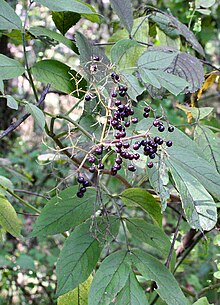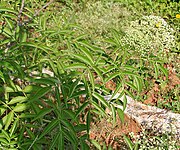Sambucus canadensis
| Sambucus canadensis | |
|---|---|

| |
| Foliage and fruit | |
| Scientific classification | |
| Kingdom: | Plantae |
| Clade: | Tracheophytes |
| Clade: | Angiosperms |
| Clade: | Eudicots |
| Clade: | Asterids |
| Order: | Dipsacales |
| Family: | Adoxaceae |
| Genus: | Sambucus |
| Species: | S. canadensis
|
| Binomial name | |
| Sambucus canadensis | |

| |
| Natural range of Sambucus canadensis in the United States and Canada | |
| Synonyms[3] | |
|
Sambucus nigra subsp. canadensis (L.) Bolli | |
Sambucus canadensis, the American black elderberry, Canada elderberry, or common elderberry, is a species of elderberry native to a large area of North America east of the Rocky Mountains, south to Bolivia.[4][3] It grows in a variety of conditions including both wet and dry soils, primarily in sunny locations.
Description[]
It is a deciduous suckering shrub growing to 3 m or more tall. The leaves are arranged in opposite pairs, pinnate with five to nine leaflets, the leaflets around 10 cm long and 5 cm broad. In summer, it bears large (20–30 cm diameter) corymbs of white flowers above the foliage, the individual flowers 5–6 mm diameter, with five petals.
The fruit (known as an elderberry) is a dark purple to black berry 3–5 mm diameter, produced in drooping clusters in the fall.

Flowers

Foliage
Fruits
Taxonomy[]
It is closely related to the European Sambucus nigra. Some authors treat it as conspecific, under the name Sambucus nigra subsp. canadensis.[5]
Toxicity[]
Inedible parts of the plant, such as the leaves, stems, roots, seeds and unripe fruits, can be toxic at lethal doses[6][7] due to the presence of cyanogenic glycosides, and alkaloids.[8] Traditional methods of consuming elderberry includes jams, jellies, and syrups, all of which cook down the fruit and strain out the seeds.
Unpublished research may show that S. canadensis (American elderberry) has lower cyanide levels than apple juice, and that its fruit does not contain enough beta-glucosidase(which convert glucosides into cyanide) to create cyanide within that biochemical pathway.[9] For comparisons, assuming S. nigra has levels of no more than 25 micrograms of cyanogenic glycosides/milligram of berry weight,[10] assuming all of the glycosides were converted to cyanide, and assuming a toxicity of 50 mg for a 50 kg vertebrate,[11] one would need to eat 2 kilograms (~4.4 pounds) of berries in one sitting to reach the lower limits of lethal toxicity (1 mg cyanide/kg of weight). For the upper limits (3 mg/kg), one would need to eat 6 kg or ~13 pounds.
Uses[]
The flower, known as elderflower, is edible, as well as the ripe berries. Uses for the fruit include wine, jelly and dye. Leaves and inner bark can be used as an insecticide and a dye.[12] Leaves are also traditionally used in herbalism topically.[citation needed]
The genus name comes from the Greek word sambuce, an ancient wind instrument, in reference to the removal of pith from the twigs of this and other species to make whistles.[13][14] Other sources claim that the sambuca was an ancient stringed instrument made from the wood of the elder tree.[citation needed]
References[]
- ^ "NatureServe Explorer 2.0 - Sambucus nigra ssp. canadensis, Common Elderberry". explorer.natureserve.org. Retrieved 6 May 2020.
- ^ "Sambucus nigra ssp. canadensis (L.) R. Bolli". ITIS Report. ITIS. Retrieved 13 July 2020.
- ^ a b "Sambucus canadensis". Germplasm Resources Information Network (GRIN). Agricultural Research Service (ARS), United States Department of Agriculture (USDA). Retrieved 26 December 2017.
- ^ "Sambucus canadensis L." Plants of the World Online. Royal Botanic Gardens, Kew. Retrieved 6 June 2020.
- ^ "Sambucus nigra". Integrated Taxonomic Information System.
- ^ Peterson, Lee Allen (1977). Edible Wild Plants: Eastern/Central North America. Boston: Houghton Mifflin Company. p. 172. ISBN 0-395-92622-X.
- ^ Preston, Richard J.; Braham, Richard R. (2002). North American Trees: Fifth Edition. Ames, Iowa: Iowa State Press. p. 199. ISBN 0-8138-1526-6.
- ^ "Sambucus canadensis". North Carolina State Extension.
- ^ "The Essential Herbal Blog: Elderberry - New Research". 15 March 2020.
- ^ https://www.researchgate.net/figure/Concentration-g-mg-1-FW-of-CNglcs-Sambunigrin-a-and-prunasin-b-mean-SE_fig2_332958627
- ^ Oke OL. 1969. The role of hydrocyanic acid in nutrition. World Rev. Nutr. Diet. 11:170–98
- ^ "Sambucus canadensis". Plants for a Future.
- ^ Niering, William A.; Olmstead, Nancy C. (1985) [1979]. The Audubon Society Field Guide to North American Wildflowers, Eastern Region. Knopf. p. 448. ISBN 0-394-50432-1.
- ^ Little, Elbert L. (1980). The Audubon Society Field Guide to North American Trees: Eastern Region. New York: Knopf. p. 670. ISBN 0-394-50760-6.
- NatureServe secure species
- Sambucus
- Flora of North America
- Flora of South America
- Plants described in 1753
- Taxa named by Carl Linnaeus
- Berries
- Bird food plants
- Edible plants
- Medicinal plants of North America



